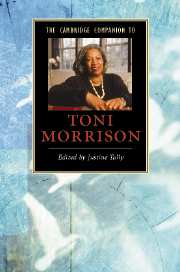Book contents
- Frontmatter
- Introduction: “All necks are on the line”
- Part I Toni Morrison’s fiction
- 1 The Bluest Eye and Sula: black female experience from childhood to womanhood
- 2 Song of Solomon and Tar Baby: the subversive role of language and the carnivalesque
- 3 Beloved or the shifting shapes of memory
- 4 Jazz and Paradise: pivotal moments in black history
- 5 The Morrison trilogy
- 6 Love and the survival of the black community
- 7 The artistic impulse of Toni Morrison’s shorter works
- Part II Toni Morrison’s criticism and editing
- Part III Essays
- Part IV Further Reading
- Index
1 - The Bluest Eye and Sula: black female experience from childhood to womanhood
from Part I - Toni Morrison’s fiction
Published online by Cambridge University Press: 28 January 2008
- Frontmatter
- Introduction: “All necks are on the line”
- Part I Toni Morrison’s fiction
- 1 The Bluest Eye and Sula: black female experience from childhood to womanhood
- 2 Song of Solomon and Tar Baby: the subversive role of language and the carnivalesque
- 3 Beloved or the shifting shapes of memory
- 4 Jazz and Paradise: pivotal moments in black history
- 5 The Morrison trilogy
- 6 Love and the survival of the black community
- 7 The artistic impulse of Toni Morrison’s shorter works
- Part II Toni Morrison’s criticism and editing
- Part III Essays
- Part IV Further Reading
- Index
Summary
The Bluest Eye
The publication of The Bluest Eye (1970) heralded the arrival of a brilliant young novelist - but it took almost five years for many to sit up and take notice. Though Sarah Blackburn remarks that Toni Morrison's first novel was published “at an auspicious time when a growing, middle-class women's movement was just beginning to acknowledge the reality of its black and poor sisters,” an overview of the critical discourse of the time shows that from the readership the book received little, if any, understanding. It is noteworthy that after its first publication the novel was out of print for quite a long time. A tragic story of child abuse, with race, gender and class mixed in, The Bluest Eye is concerned with racial self-loathing, the loss of identity, and shame. Even though the setting for the story is 1940-41 - the beginning of World War II for the United States - it is also “presentist” in concept, ideologically grounded in the 1960s when “Black is Beautiful” entered into the popular, if more militant, discourse. Setting out to write a story that she herself wanted to read, Morrison worried that this slogan of racial pride would be unable to dispel the long-term psychic effects of prejudices rooted in racialism and sexism.
The locale of this imaginative narrative is Lorrain, Ohio, the protagonist Pecola Breedlove, a little black girl at the most vulnerable phase of her life. The title The Bluest Eye calls attention to itself immediately: the superlative degree of color as well as the singular form of the noun in the title is rather unusual, resulting in a pun. The singular noun may refer to the damaging white gaze; the omitted plural to the object of desire, an epitome of beauty according to mainstream society; or alternatively, to the saddest story of the demise of a child's identity (the “eye” as “I”), integral to the blues sung by Claudia's mother.
- Type
- Chapter
- Information
- The Cambridge Companion to Toni Morrison , pp. 11 - 25Publisher: Cambridge University PressPrint publication year: 2007
- 4
- Cited by

